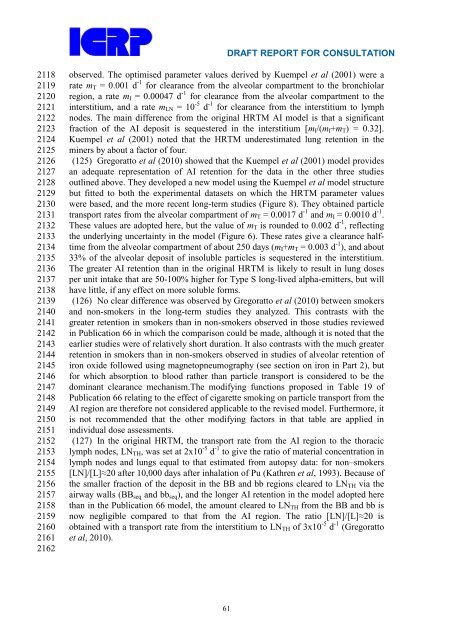Occupational Intakes of Radionuclides Part 1 - ICRP
Occupational Intakes of Radionuclides Part 1 - ICRP
Occupational Intakes of Radionuclides Part 1 - ICRP
You also want an ePaper? Increase the reach of your titles
YUMPU automatically turns print PDFs into web optimized ePapers that Google loves.
2118<br />
2119<br />
2120<br />
2121<br />
2122<br />
2123<br />
2124<br />
2125<br />
2126<br />
2127<br />
2128<br />
2129<br />
2130<br />
2131<br />
2132<br />
2133<br />
2134<br />
2135<br />
2136<br />
2137<br />
2138<br />
2139<br />
2140<br />
2141<br />
2142<br />
2143<br />
2144<br />
2145<br />
2146<br />
2147<br />
2148<br />
2149<br />
2150<br />
2151<br />
2152<br />
2153<br />
2154<br />
2155<br />
2156<br />
2157<br />
2158<br />
2159<br />
2160<br />
2161<br />
2162<br />
DRAFT REPORT FOR CONSULTATION<br />
observed. The optimised parameter values derived by Kuempel et al (2001) were a<br />
rate mT = 0.001 d -1 for clearance from the alveolar compartment to the bronchiolar<br />
region, a rate mI = 0.00047 d -1 for clearance from the alveolar compartment to the<br />
interstitium, and a rate mLN = 10 -5 d -1 for clearance from the interstitium to lymph<br />
nodes. The main difference from the original HRTM AI model is that a significant<br />
fraction <strong>of</strong> the AI deposit is sequestered in the interstitium [mI/(mI+mT) = 0.32].<br />
Kuempel et al (2001) noted that the HRTM underestimated lung retention in the<br />
miners by about a factor <strong>of</strong> four.<br />
(125) Gregoratto et al (2010) showed that the Kuempel et al (2001) model provides<br />
an adequate representation <strong>of</strong> AI retention for the data in the other three studies<br />
outlined above. They developed a new model using the Kuempel et al model structure<br />
but fitted to both the experimental datasets on which the HRTM parameter values<br />
were based, and the more recent long-term studies (Figure 8). They obtained particle<br />
transport rates from the alveolar compartment <strong>of</strong> mT = 0.0017 d -1 and mI = 0.0010 d -1 .<br />
These values are adopted here, but the value <strong>of</strong> mT is rounded to 0.002 d -1 , reflecting<br />
the underlying uncertainty in the model (Figure 6). These rates give a clearance halftime<br />
from the alveolar compartment <strong>of</strong> about 250 days (mI+mT = 0.003 d -1 ), and about<br />
33% <strong>of</strong> the alveolar deposit <strong>of</strong> insoluble particles is sequestered in the interstitium.<br />
The greater AI retention than in the original HRTM is likely to result in lung doses<br />
per unit intake that are 50-100% higher for Type S long-lived alpha-emitters, but will<br />
have little, if any effect on more soluble forms.<br />
(126) No clear difference was observed by Gregoratto et al (2010) between smokers<br />
and non-smokers in the long-term studies they analyzed. This contrasts with the<br />
greater retention in smokers than in non-smokers observed in those studies reviewed<br />
in Publication 66 in which the comparison could be made, although it is noted that the<br />
earlier studies were <strong>of</strong> relatively short duration. It also contrasts with the much greater<br />
retention in smokers than in non-smokers observed in studies <strong>of</strong> alveolar retention <strong>of</strong><br />
iron oxide followed using magnetopneumography (see section on iron in <strong>Part</strong> 2), but<br />
for which absorption to blood rather than particle transport is considered to be the<br />
dominant clearance mechanism.The modifying functions proposed in Table 19 <strong>of</strong><br />
Publication 66 relating to the effect <strong>of</strong> cigarette smoking on particle transport from the<br />
AI region are therefore not considered applicable to the revised model. Furthermore, it<br />
is not recommended that the other modifying factors in that table are applied in<br />
individual dose assessments.<br />
(127) In the original HRTM, the transport rate from the AI region to the thoracic<br />
lymph nodes, LNTH, was set at 2x10 -5 d -1 to give the ratio <strong>of</strong> material concentration in<br />
lymph nodes and lungs equal to that estimated from autopsy data: for non–smokers<br />
[LN]/[L]≈20 after 10,000 days after inhalation <strong>of</strong> Pu (Kathren et al, 1993). Because <strong>of</strong><br />
the smaller fraction <strong>of</strong> the deposit in the BB and bb regions cleared to LNTH via the<br />
airway walls (BBseq and bbseq), and the longer AI retention in the model adopted here<br />
than in the Publication 66 model, the amount cleared to LNTH from the BB and bb is<br />
now negligible compared to that from the AI region. The ratio [LN]/[L]≈20 is<br />
obtained with a transport rate from the interstitium to LNTH <strong>of</strong> 3x10 -5 d -1 (Gregoratto<br />
et al, 2010).<br />
61

















